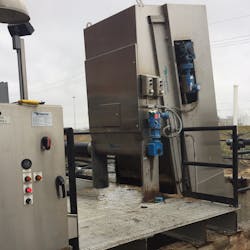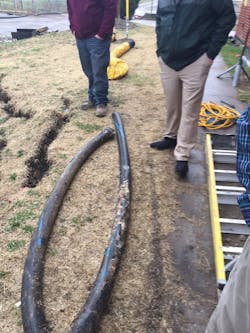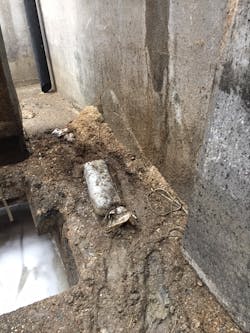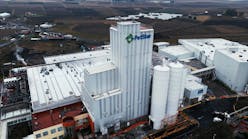It’s not surprising that industrial complexes tend to spring up near water. After all, water is at the heart of thriving industry, from fabricating, processing, cooling and sanitation in the facility to transporting a product and even incorporating water into a product. Because water used in industrial processes requires treatment, it makes sense that wastewater treatment plants are also often found nearby.
Unfortunately, though, the negative weather impacts from flooding can dampen the benefits of a riverside location. One of those impacts for the South St. Joseph Industrial Sewer District (SSJISD) was a large, 80-by-50-foot sinkhole that opened up after record rains in March 2019 caused the Missouri River to flood. About 4,200 people in St. Joseph and the neighboring town of Elwood, Kansas, were temporarily evacuated. Damage was minimal for the SSJISD, even though tons of sand ended up on top of important processing equipment. One piece of equipment, the Duperon FlexRake bar screen, displayed unexpected resilience under the weight of 600 tons of sand.
Application
SSJISD is an industrial primary treatment plant in St. Joseph, Missouri, that serves sixteen different industries in the southern portion of the city. The plant is not privately owned but is a sewer district formed under the statutes of the state of Missouri. It is governed by a Board of Supervisors comprised of individuals from the industries that are served. The plant is completely mechanical and processes an average of 1.5 to 2 million gallons per day (MGD) of wastewater with a peak flow of 15 MGD.
Raw wastewater enters the plant via a 60-inch concrete line and then flows through the bar screen. Screenings from this part of the process are hauled to a landfill for disposal. Once through the screening system, wastewater enters the main wet well and is pumped up and into the treatment plant for primary treatment. It flows into one of two 90,000-gallon grit tanks for grit and grease removal. From there, the material is pumped into one of two large anaerobic digesters for digestion and storage until the material meets requirements for land application. The wastewater flows into the primary clarifier for further processing, where additional solids are removed and directed to the digester tanks. The plant performs no chemical or biological treatment, and any solids that remain after the processing and drying are transported out of the facility to land application sites.
Finding the Right Fit
SSJISD was looking to replace its old, non-operational grit removal equipment that had been installed in 1960. The District knew it had to protect its downstream equipment with a robust bar screening system that could handle large solids loading with unusual and inconsistent debris. The main debris processed through SSJISD includes grit, meat, woodchips, and a significant amount of grease from industries such as pet food, soy and food processing, and related activities such as truck washing. Anywhere from two to six 20-yard dumpsters are processed per week.
When the time came to make a decision, the Duperon FlexRake was sole sourced. The FlexRake bar screen uses a mechanically simple front-clean, front-return bar screen design that adapts to a wide range of debris conditions, making it an easy and ideal choice for SSJISD.
“The bar screening system at SSJISD is used to prevent damage to expensive treatment tanks,” said plant manager Chad Coleman. “To protect those tanks from a variety of inconsistent debris and material, we needed equipment with very low maintenance requirements and reliable durability. The FlexRake stood out as the best available option.”
In 2012, SSJISD installed a 5-foot-by-34-foot Duperon FlexRake, a full penetration, fine-screen bar screen with a quarter-inch bar opening. Additionally, a Duperon auger conveyor complements the bar screen technology and was custom modified to meet the District's unique needs.
Another feature that had influenced SSJISD’s decision was the FlexRake multifunctional FlexLink link system that lifts and pivots around debris, allowing adaptability to the wide range of debris variations that are received at SSJISD. The high debris capture rate, 5-pound stainless-steel cast links and an ultimate strength of 60,000 pounds offered a robust resilience that would be more critical than SSJISD could have foreseen.
Putting the Bar Screen to the Test
In March 2019, after seven years of trouble-free operation, high groundwater levels caused by historic water levels in the Missouri River triggered a huge sinkhole just outside the SSJISD plant. The sinkhole caused an 18-inch pipeline to fail, propelling tons of sand through the plant’s system. Approximately 45 dump-truck loads of sand — 600 tons! — were removed from the main line and from the grit tanks and clarifiers. The FlexRake bar screen actually handled much of the sand that entered the line, about 15–20 tons.
Resilience and Financial Benefit
The resilience of the Duperon system under extreme conditions has not only provided SSJISD with peace of mind, it has also come with significant financial benefit. The District estimates that if it had still been running its previous screening system, it would have surely broken under the weight of the sand, costing upwards of $150,000 to $200,000 to replace. Even before the sinkhole, other savings had been realized over the years, including the cost of replacing and repairing damage to downstream equipment like replacement flights and chain as well as the labor to repair grit tanks. Additionally, the FlexRake bar screen has successfully removed solids that can be taken to the landfill at the beginning of the process, preventing tons of solids from reaching the anaerobic lagoons that SSJISD would have had to land apply each year. All told, Coleman estimated the Duperon technology has saved the District as much as $100,000 per year. Extrapolated over the eight years of ownership, that’s nearly a million dollars.
SSJISD has been very satisfied with the FlexRake equipment and Duperon Corporation. Coleman noted, “With the overall facility cost savings over eight years, the demonstrated reliability and durability during the sinkhole incident, and customer service that has been second to none, the investment we madeAbout the Author: Dan Courser, M.E., has been designing and supporting industrial equipment for 20 years. For the last 9 years he has been serving in the water industry at Duperon Corporation with a passion for creating robust equipment that makes a difference for our customers and for water in the world. Courser graduated from Michigan Technological University with a BS in mechanical engineering.







